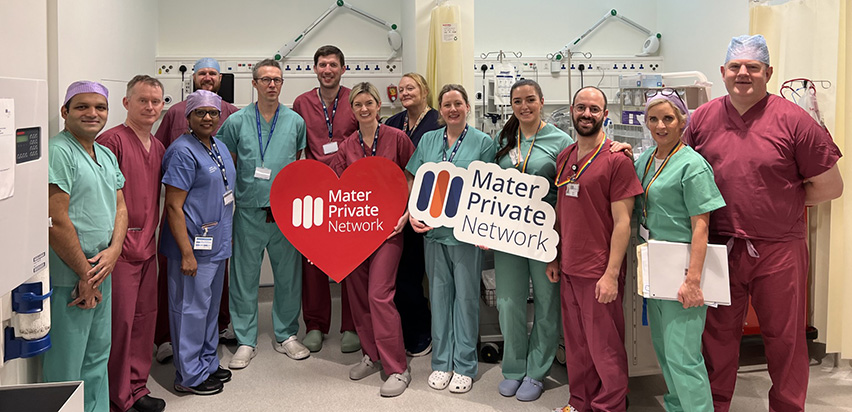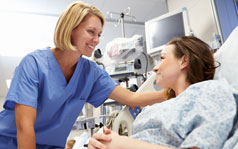Lung Cancer
I’ve been told that I have lung cancer. What is it exactly?
When you breathe in, air passes through your nose or mouth into your trachea (windpipe) and separates into two further tubes (bronchi). Each of these bronchi connects to a lung.
When cancer develops in the lungs, the cells change and grow in an abnormal way. Many lung cancers begin in the wall of the bronchi. As the cancer grows it forms a collection of cells (tumour). This tumour can cause a blockage and result in the symptoms of lung cancer, such as difficulty breathing.
There are several forms of lung cancer and treatment for these cancers can include chemotherapy, biological therapy, radiotherapy, and surgery.
What are the risk factors for lung cancer?
Lung cancer can occur in men and in women. In Ireland it is the fourth most common cancer. About 2,000 people are diagnosed with lung cancer in Ireland every year. Some of the major causes of this cancer are:
- Age: like most types of cancer, lung cancer is more common in older people. About 80% (8 in 10) of lung cancers are diagnosed in people over 60. Lung cancer rarely affects people under 40.
- Cannabis: it is believed that smoking cannabis can do the same damage to the lungs as smoking cigarettes.
- Passive smoking: this also increases your risk of developing lung cancer, although not as much as a smoker.
- Vaping: more long-term studies are required to understand the effect of vaping on the lungs, but it is believed that vaping has the potential to cause damage.
- Asbestos exposure: being exposed to asbestos over a long time can cause mesothelioma, a type of lung cancer.
- Radon: radon is a gas normally found in the soil. Being exposed to high levels of radon has been linked to lung cancer.
Mater Private is keen to provide services that will assist in the early detection of this disease and has a symptomatic lung cancer rapid access clinic and a specialised screening service.
What are the symptoms of lung cancer?
There are many common symptoms for lung cancer including:
- Difficulty breathing
- A cough that doesn’t go away or a change in a long-term cough
- Repeated chest infections that won’t go away even after antibiotics
- Wheezing
- Feeling more tired than usual
- A hoarse voice
- Coughing up blood-stained phlegm
- Pain in your chest, especially when you cough or breathe in
- Loss of appetite
- Weight loss
- Swelling around your face and neck
- Difficulty swallowing
What are the types of lung cancer?
Small cell lung cancer
The condition is called this because when the cancer cells are looked at under a microscope they are very small. It is usually caused by smoking and is often fast-growing and can spread quite quickly.
Non-small cell lung cancer
There are three types of this cancer:
- Squamous cell carcinoma: this is the most common type of lung cancer. It develops in the cells that line the airways and is often caused by smoking.
- Adenocarcinoma: this develops from the cells that produce mucus (phlegm) in the lining of the airways.
- Large cell carcinoma: this gets its name from the large, rounded cells that are seen when they are examined under a microscope. It is sometimes known as undifferentiated carcinoma.
About 15–20% (one in five) of lung cancers are small cell, the rest are non-small cell.
Mesothelioma
This is a less common type of cancer that can affect the covering of the lungs. This is a cancer of the membrane which covers the surface of the lungs and lines the inside of the chest. It often occurs in people who have been exposed to asbestos.
Carcinoid Tumour
A rare type of cancer called a carcinoid tumour can sometimes develop in the lungs. Carcinoid tumours are a type of neuroendocrine cancer. The neuroendocrine system is a network of glands that produce hormones and send them into the bloodstream to affect the function of different organs in the body. Rarer types of cancer, such as soft tissue sarcomas, can also develop in the lungs.
How is lung cancer diagnosed?
We use a broad range of tests that measure how well the lungs take in and exhale air and how efficiently they transfer oxygen into the blood. These are know as diagnostic pulmonary function tests.
- Bronchoscopy: this test uses a small tube with a camera at one end. It is passed down your airway through either your nose or your mouth. Your doctor then passes the tube right down through your airways and into your lungs. Here photos and samples from the lung tissue can be taken.
- Endobronchial ultrasound (EBUS): this is a special type of bronchoscopy that uses an ultrasound scan to take pictures inside and outside the lungs.
- Lung biopsy: during a bronchoscopy, EBUS or CT scan, your doctor can take small amounts of tissue samples from your lung. These are called biopsies. Biopsies are sent to a laboratory and looked at under a microscope.
- Mediastinoscopy: in this test your doctor looks into the central part of your chest at the lymph glands. This is to check if the disease has spread. It uses a small tube with a camera, similar to that used in a bronchoscopy. Your doctor will first make a small cut at the base of your neck and put the tube in. Samples (biopsies) of this tissue can also be taken.
What are the treatments for lung cancer?
The main treatments for lung cancer are:
- Chemotherapy: is the use of anti-cancer (cytotoxic) drugs to destroy cancer cells in the body by stopping or slowing the growth of cancer cells.
- Biological therapy: is a type of treatment that uses the body's immune system to kill cancer cells.
- Radiotherapy: uses high-energy rays to damage cancer cells and stop them from growing and dividing.
- Surgery: aims to remove the part of the lung containing cancer. Lung cancer surgery can involve removing a portion of the lung or the entire lung.









